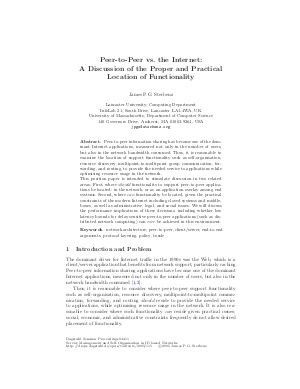Peer-to-Peer vs. the Internet: A Discussion on the Proper and Practical Location of Functionality
Author James P.G. Sterbenz
-
Part of:
Volume:
Dagstuhl Seminar Proceedings, Volume 4411
Part of: Series: Dagstuhl Seminar Proceedings (DagSemProc) - License:
 Creative Commons Attribution 4.0 International license
Creative Commons Attribution 4.0 International license
- Publication Date: 2005-03-24
File

PDF
DagSemProc.04411.14.pdf
- Filesize: 135 kB
- 10 pages
Document Identifiers
Subject Classification
Keywords
- network architecture
- peer-to-peer
- client/server
- nd-to-end arguments
- protocol layering
- policy
- ussle
Metrics
- Access Statistics
-
Total Accesses (updated on a weekly basis)
0Document
0Metadata
Abstract
Peer-to-peer information sharing has become one of the dominant Internet applications, measured not only in the number of users, but also in the network bandwidth consumed. Thus, it is reasonable to examine the location of support functionality such as self-organisation, resource discovery, multipoint-to-multipoint group communication, forwarding, and routing, to provide the needed service to applications while optimising resource usage in the network. This position paper is intended to stimulate discussion in two related areas: First, where {\em should} functionality to support peer-to-peer applications be located: in the network, or as an application overlay among end systems. Second, where {\em can} functionality be located, given the practical constraints of the modern Internet including closed systems and middleboxes, as well as administrative, legal, and social issues. We will discuss the performance implications of these decisions, including whether low latency bounds for delay sensitive peer-to-peer applications (such as distributed network computing) can ever be achieved in this environment.
Cite As Get BibTex
James P.G. Sterbenz. Peer-to-Peer vs. the Internet: A Discussion on the Proper and Practical Location of Functionality. In Service Management and Self-Organization in IP-based Networks. Dagstuhl Seminar Proceedings, Volume 4411, pp. 1-10, Schloss Dagstuhl – Leibniz-Zentrum für Informatik (2005)
https://doi.org/10.4230/DagSemProc.04411.14
BibTex
@InProceedings{sterbenz:DagSemProc.04411.14,
author = {Sterbenz, James P.G.},
title = {{Peer-to-Peer vs. the Internet: A Discussion on the Proper and Practical Location of Functionality}},
booktitle = {Service Management and Self-Organization in IP-based Networks},
pages = {1--10},
series = {Dagstuhl Seminar Proceedings (DagSemProc)},
ISSN = {1862-4405},
year = {2005},
volume = {4411},
editor = {Matthias Bossardt and Georg Carle and D. Hutchison and Hermann de Meer and Bernhard Plattner},
publisher = {Schloss Dagstuhl -- Leibniz-Zentrum f{\"u}r Informatik},
address = {Dagstuhl, Germany},
URL = {https://drops.dagstuhl.de/entities/document/10.4230/DagSemProc.04411.14},
URN = {urn:nbn:de:0030-drops-1156},
doi = {10.4230/DagSemProc.04411.14},
annote = {Keywords: network architecture , peer-to-peer , client/server , nd-to-end arguments , protocol layering , policy , ussle}
}
